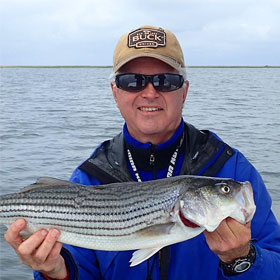A Primer on Muskie Fishing for Beginners
By Ken Schultz
Nov 15, 2019
Info on muskie fishing for beginners: what muskies eat, what tackle and lures work best, where to fish for muskies, and what techniques to use.
It’s a fact that you can’t expect to catch muskies in great numbers, or even each time you go fishing. Yet those who know how to catch muskies score pretty well, with fall muskie fishing being especially productive. Successful muskie fishing requires discipline, dedication, patience, and a lot of hours on the water. This primer on muskie fishing for beginners will help you get started.
What Muskies Eat
Muskies are an apex predator and eat a lot of different fish, many of which are fairly large in size. Among their top foods are yellow perch, suckers, golden shiners, and walleyes, with smallmouth bass and many other fish on their menu.
Tackle Needs
Heavy tackle is the norm. A stiff, and relatively short, rod is standard, with at least 25- to 40-pound line, though many diehard muskie anglers use thin-diameter microfilament lines from 50- to 80-pound strength. It’s hard to set the hook well into a large muskie, so multiple hooksetting and a low-stretch line can be advantageous. A wire leader is also used, usually from 12 to 24 inches long.
Top-Producing Lures
Popular muskie lures include large jigs, jerkbaits, surface plugs, bucktail spinners, and some diving plugs. Bucktails and jerkbaits are especially favored for casting, as well as large topwater lures. These are particularly good over the top of submerged cover, and along the edges of shallow submerged cover. Black is the top producer.
Large, shallow-running minnow-style plugs are also effective, especially around the edges of weeds and sometimes over the top of deeply submerged vegetation.
Diving plugs can be both cast and trolled. Popular colors include perch, walleye, bass, and muskie patterns, plus black, black-and white, chartreuse, silver-and-black, and yellow
Techniques
A brief primer on muskie fishing for beginners can’t cover all techniques, so let’s highlight the most important things to know:
- Casting and trolling are both effective, although trolling may not be allowed in some waters.
- Casting is usually done over very specific areas and types of cover. When large lures are used, combined with a stout rod and reel, it can be very demanding.
- Trolled lures are fished on fairly short lines; since muskies are seldom deterred by boat noise, some are caught right in the prop wash.
- A downside to trolling is that because muskies will pursue a cast-and-retrieved lure right to the boat, occasionally striking at boatside, trollers don't see fish that might follow their lures.
- This following tendency shows an angler where a fish is located. Good muskie anglers remember all of the places where they have caught and seen fish on their favorite waters, so they visit these places regularly.
- Most muskies are caught less than 30 feet deep, often from 15 to 25 feet. Sometimes they’re much shallower. Most casters lure fish in from 5 to 15 feet deep while trollers usually catch them from 8 to 30.
Where to Find Muskies
In many lakes, muskies tend to stay in one general area, often holding in or near thick weedbeds waiting for prey. Prime places to fish are the underwater area where weeds end and deep water begins (called a breakline), and irregular contour features.
A long underwater slope near deep water, especially if it breaks sharply to 20 or 25 feet, is also a top location. Even better if there is heavy vegetation nearby or rock piles on the breaklines. Also good are shoals, submerged islands, and bars.
In rivers, pay attention to how the current washes around structure or cover. A good place is a point or shoal washed by strong current. Another is one where two flows converge. Don’t ignore back eddies, slicks, and current edges.
Fall muskie fishing is arguably likely to be more productive, as these fish are putting on the feed bag before winter.









